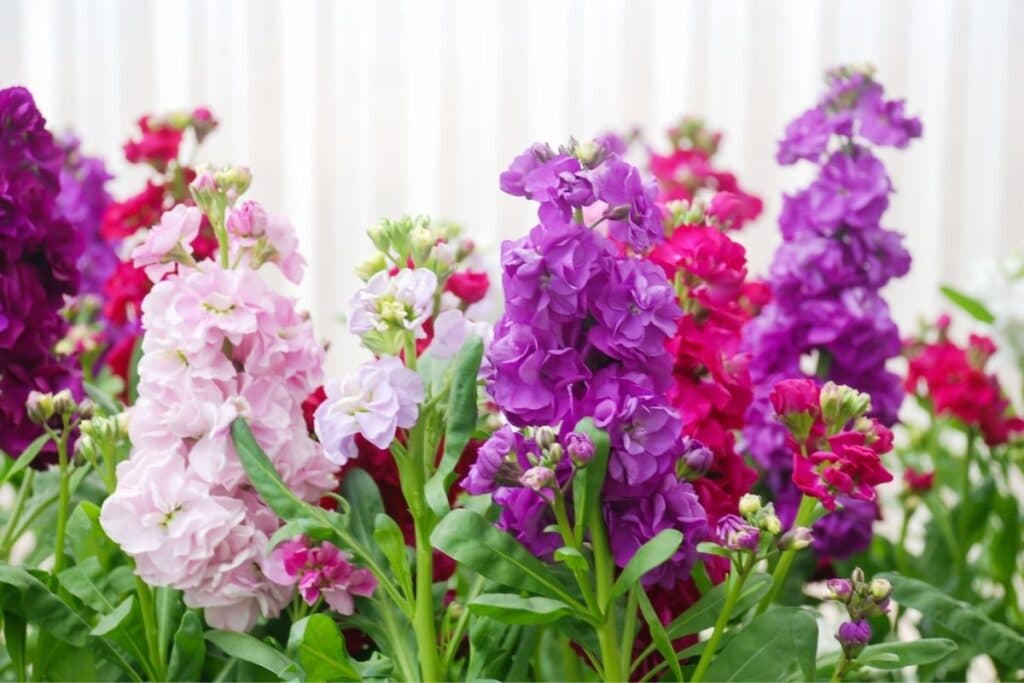As a member of the mustard family, the stock flower is a gorgeous plant with delicate flowers and an enticing scent. There are more than 55 species of stock flowers, all of which are members of the Matthiola family.
This plant first rose to popularity in England, where it was grown in English gardens and bred exclusively for ornamental use.
Today, the stock flower has a variety of meanings that are helpful for gardeners to be aware of. Do you know the meaning of the stock flower? If not, you’ve come to the right place. In this post, we’ll give you a complete guide to the stock flower meaning and symbolism.
What Does Stock Flower Mean?
The botanical name of the stock flower is Matthiola, a nod to Pierandrea Matthiola, who was an Italian doctor and botanist who first cultivated these flowers for their medicinal benefits. He once thought that the flowers could promote feelings of love and lust with their strong, cloying scent.
Although that ultimately was not the case, it’s hard to deny the fact that stock flowers help to promote long-lasting beauty, contentment, and happiness.
Other Flower Names Besides the Common Name ‘Stock’
They’re often referred to as gillyflowers, with the name a bit confusing since this term was also used widely in the 1300s to 1500s to refer to fragrant flowers like wallflowers, carnations, and dianthus.
In most documents of this time, the name gillyflower was not used to refer to stock flowers, including those by Shakespeare. However, the term “gillyflower” became more common after this period when used in reference to stock flowers.
The stock flower, or Matthiola incana, is also referred to by common names such as ten-week stock, hoary stock, common stock, and Brompton stock. Most are grown as annuals.
Stock flowers are sometimes referred to as Virginia stock plants because they are found growing naturally in Virginia. However, the plant is native to the warmer regions of the world, such as South Africa.
Another fun fact to be aware of when it comes to the stock flower is that this plant is actually a part of the mustard family – the Brassicaceae family – (and is closely related to plants like broccoli and turnips, though not nearly as delicious).
To ensure the best way to cultivate these flowers, make sure to water them frequently. Stock flowers prefer moist soil, so it’s important to keep an eye on the soil moisture levels and water them as needed. During hot, dry spells, be sure to water them a little extra.
One of the great things about Stock flowers is that they have so many medicinal values. In fact, they were used in herbal medicine as far back as the Victorian era. The flowers contain chemicals that can be used to treat a range of ailments, from digestive issues to poisonous bites and stings. So not only are they beautiful to look at, but they have some serious health benefits too!
What Does Stock Flower Symbolize?
Stock flowers, members of the matthiola genus, most often symbolize success, contentment, and overflowing affection. They can also symbolize a happy life and a contented existence. Sometimes called gillyflowers, the flower meaning can vary by color – more on this below.
Ultimately, the stock flower is a beautiful plant that is prized for its cloying scent, its attractive blossoms, and other physical characteristics.
Stock flowers have a gently twisting spike of blooms that can mean several things depending on the situation and the recipient of the gift. Stock flowers can be used to symbolize beauty that never fades, contentment with your life at the moment, or even a life that is filled with happiness and success.
The stock flower can also be used to symbolize dedication (particularly spiritual dedication), connection to the rest of the world, or the ability to achieve paradise on earth.
Stock flowers are often used at weddings because they are so adept at symbolizing commitment and lifelong happiness. However, they’re appropriate for just about any situation, since the cloying scent will invite you to celebrate and enjoy life whenever and however you can!
Stock Flower: Particular Color Meaning
Stock flowers are usually white, pink, or red with the meaning of the flower changing slightly with the different shades.
Here’s a guide to the meaning of the individual colors.
What Do Red Stock Flowers Symbolize?
Red stock flowers symbolize passion and romantic love. They’re great for giving to any beautiful woman in your life!
What Do Pink Flowers Symbolize?
Pink stock flowers can be used to symbolize purity while purple and blue represent more sedated feelings of joy. These are great to give to a new family member.
What Do Orange or Yellow Stock Flowers Represent?
There are even orange and yellow stock flowers that can be used to symbolize happiness!
What is the Cultural Significance of a Stock Flower?
Native to the Mediterranean region, the stock flower is widely used as an ornamental and cut flower. It has been cultivated since at least the 1500s and while stock flowers’ uses are primarily decorative, it can also be grown for its edible flowers.
The stock flower’s blossoms taste much like radishes with a spicy, delicious flavor that adds zest to salads. The flowers can also be used for a garnish.
Wait until the seed pods appear and you can eat them before they dry up and get hard. The only part of the plant that should not be eaten is the leaves and the roots since they taste quite bitter.
What is the Symbolism of a Stock Flower Tattoo?
Stock flowers can be used to symbolize a bond of affection or promptness when used as a tattoo. It can also symbolize everlasting beauty and genuine, heartfelt emotion.
Choose a stock flower for a tattoo and you’ll look upon it fondly whenever it catches your gaze.
How to Cultivate Flowers in the Stock Family
If you’re interested in cultivating flowers in the Stock family, you’re in luck! These beautiful, long-lasting blooms are highly sought after for their medicinal values and stunning appearance. Here’s how to cultivate them to ensure optimal growth and success.
First and foremost, it’s important to provide these perennial plants with well-draining soil. They prefer a soil that is evenly moist, but not waterlogged, so make sure to choose a spot with good drainage. Additionally, they thrive in full sun to partial shade, so choose a spot that receives plenty of light but not too much direct sun.
Finally, if you want to ensure long-lasting blooms, it’s important to deadhead the spent flowers. This will encourage the plant to produce more blooms and will keep it looking tidy and healthy throughout the growing season.
Overall, cultivating Stock flowers is a great way to add some color and beauty to your garden, while also reaping their many health benefits. Just make sure to choose a spot with well-draining soil, keep the soil evenly moist, water frequently, and deadhead spent flowers.
When Should You Give Someone a Stock Flower?
The stock flower is an appropriate flower to give in just about any situation since it does not possess any negative connotations. However, the best time to give someone a stock flower would be at a wedding, birthday, or anniversary.
You could even give stock flowers to someone for their first communion!
That said, the stock flower is an appropriate gift to give during any positive life change, whether it’s a new job, a new baby, or a move to a new city. Stock plants the perfect bloom for any occasion!
Explore our blog for more flower color meanings.
*image by [email protected]/depositphotos







